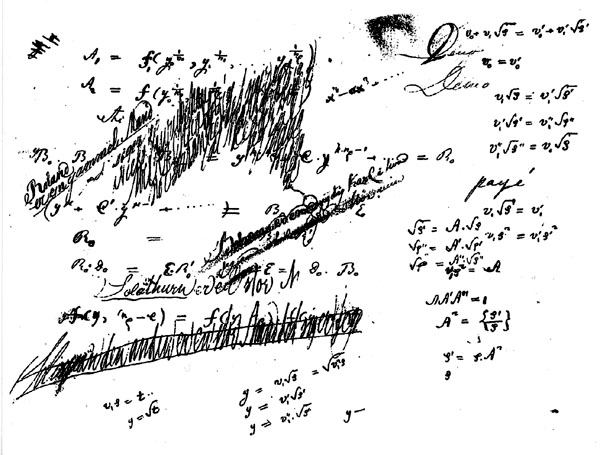GMAT Study Plan #1: Cram Weekend
 Cramming for the GMAT goes wrong more often then it goes right, but it is sometimes the only rational and feasible way to prepare quickly for the GMAT exam. If you are very good at standardized tests, and/or you are under a time crunch to apply, it may be worth a shot. If you are considering cramming for the GMAT, you can use this plan to get started. You will have an opportunity to exit this plan and switch to a more thorough study plan shortly. If you are definitely cramming for the GMAT, you can use this plan to optimize your chances of scoring your best on the test.
Cramming for the GMAT goes wrong more often then it goes right, but it is sometimes the only rational and feasible way to prepare quickly for the GMAT exam. If you are very good at standardized tests, and/or you are under a time crunch to apply, it may be worth a shot. If you are considering cramming for the GMAT, you can use this plan to get started. You will have an opportunity to exit this plan and switch to a more thorough study plan shortly. If you are definitely cramming for the GMAT, you can use this plan to optimize your chances of scoring your best on the test.
Cramming: The Basics
This plan assumes that you will have at least 2-3 days to prepare for the GMAT exam. Of course, if you have a little extra time then you should certainly make use of it, and in that case you can look at this plan, download the template, but also incorporate elements from the “Final Exam Week” study plan.
This plan is very simple and has two major milestones:
- Milestone #1 is to familiarize yourself with the GMAT.
- Milestone #2 is to take a full-length practice test under good conditions and then to review that test very thoroughly.
And, oh yeah, you need a test date, of course. Depending on where you are located and whether you want to take the GMAT during on a day and at a time that is popular, you may find that exam seats are all booked up. Realistically, if you’re near a major metro and you are willing to travel and take a day off if necessary, you can usually book within a couple of days.
The Key is to Familiarize Yourself
Since time is of the essence, you may be tempted to go straight to a full-length practice test. This would be a mistake. You should familiarize yourself with the test and especially with the Data Sufficiency question format before taking a full-length practice test. After you familiarize yourself with the test, your practice test score will be more accurate and your practice test experience will be more similar to what you will actually experience when you sit for the GMAT in the testing center.
Before taking a full-length practice test, you should first know the basics about the exam. Knowing the sections and the timing for each section, for example, will allow you to take the test without being distracted by these things. This way you can focus on the questions and on time management. Reviewing all of this will take less than an hour. To review this, you can head to the GMAT basics section of this course where you can learn about the timing, the adaptive nature of the test, and so forth.
The next thing that you need to do before taking a full-length practice test is to get to know the question types a bit, especially the Data Sufficiency question type. These are unique to the GMAT and your performance on this question type will not be ideal to begin with. Regardless of how good you might be doing on the Data Sufficiency questions, you won’t be at your ideal level yet. You need to practice at least a small amount on these question types. Before you take your first practice test, spend at least an hour doing and reviewing data sufficiency questions. You can do so in this course by heading straight over to the Data Sufficiency section and starting with the first Data Sufficiency module. Each module is quite short, so go ahead and complete it, and then you can head back to the main page of the course and skip to a different Data Sufficiency module.
A Walk-Through of the Cram Weekend
Let’s imagine that you are studying for the GMAT over a weekend. In this case, you can devote parts of a Saturday to getting to know the test. Then you can devote Sunday to reviewing the test. In that case, your schedule could go a little bit like this:
- On Saturday morning, you go through the GMAT basics section of this course. You should also spend at least an hour doing Data Sufficiency questions. If you have a little extra time it would be great to do some questions of all the other question types as well. This might take you up to about lunchtime.
- Saturday afternoon, you can break for lunch and gather your strength and attention for a full-length practice test. You’ll want to allocate four hours, have your cell phone off, and take the entire test straight through without skipping any sections.
(Alternatively, maybe you’ve had a chance to do all this preliminary familiarization on Friday night. If this is the case, that’s wonderful, because then you can start your practice test on Saturday morning. Either way, once you’ve had a time to take a break and prepare yourself, you can take the practice test.)
- Once you’ve taken the practice tests, take 20 minutes to clear your brain. Then, it’s time to evaluate.
As we cover in the other chapter on practice tests, there are only two practice tests that will give you an accurate estimation of your score. These are the two GMAT prep tests that you can download from mba.com. This practice test, the first you will take, should give you a fairly accurate score. Since, with this study plan, you’re not going to have much time to study further, your practice test score should be close to what you will earn on the actual GMAT. Of course, you might score higher when you take the GMAT, but you might also score lower. Because of this, now is a good time to pause and ask yourself whether the score that you got on your first practice test would be acceptable as your GMAT score. You’re probably going to end up with a score close to your practice test score; it is quite unlikely that you will score any more than 20 or 30 points higher on the actual GMAT. So if you’re looking for a 720 on the GMAT and you get a 600 on your practice tests, there is little point in sitting for the exam. That is, unless you really were not performing normally or optimally on the practice test. Now you can see why it’s useful to take the practice test seriously, because if you don’t take it seriously and then you earn low score, you will have a troubling piece of data that may or may not be reliable.
Let’s say that you take the practice test and you’re roughly in the ballpark of your target score. For example, if you’re hoping for a 720 and you get a 680 on your practice test, you have a fighting chance of getting a 720 in a couple days. It’s difficult to improve your GMAT score, but in the very beginning stages of your preparation, there’s usually some room to improve. This is where the final phase of the Cram Study Plan comes in. This is the final phase:
- Review the practice test very thoroughly.
Many people are not all that good at reviewing their own work and questions. However, this is your opportunity to figure out how to cram effectively and improve your score. If you are trying to improve a 680 to a 720, reviewing your exam will be your way to a higher score.
Reviewing Your Practice Exam

What does your scratchwork tell you?
In order to review your practice test effectively, the key is going to be review every question, to keep an eye on the mistakes that you made and on the things that you did well, and to expect that you’re going to see certain patterns again. For example, if you had an inequality and you multiplied both sides by a negative number without flipping the sign of the inequality, you got that question wrong. You should then make a mental note that you’re going to expect to see an inequality that involves a negative number again on the test you’re going to have to make sure to recognize this type of problem and not make the same mistake again.
A good check on whether you have reviewed the exam properly is how long the review takes. It should take almost as long to review the test as it did to take the test. For example, when you did one question on the practice test, you might have gotten it right fairly quickly, maybe even in the 15-25 seconds. But when you’re reviewing that question, there may be interesting notes or useful tips in the explanation. For example, maybe that question was answered in a different fashion than you answered it in. A minute or two to read that explanation might be necessary for full comprehension. In this case, you might actually take longer to review the exam than you did to take the exam, even though you might be reviewing questions you answered correctly. If the review is going very quickly, you are not looking carefully enough for ways to improve your game.
As you review, examine your scratch work. See exactly what you’ve done. Looking back at your scratch work will be critical to identifying ways you can improve.
If You Have “Extra” Time
Now suppose that you have done all of the steps in this plan and you have a little extra time left over. You have, at this point, familiarized yourself with the exam, done some Data Sufficiency questions and maybe some other questions, taken the first GMAT prep test, and reviewed the prep test. Your GMAT score is at least within 50 points of your target score and therefore you’re still going to keep to the Cram Study Plan and take the test in a day or so. So, what do you do with your extra time? In this case, you should prepare for the exam just as you would in a longer study plan. You should make sure that you’re rested and relaxed for the test. The best way to prepare just before the exam is to review questions, since reviewing questions is not that strenuous or stressful, but it is useful. It’s a bit like an athlete visualizing before a game, without over-exerting and wearing himself out.
For many people, another beneficial way to spend this extra time is to go back over the math review in this course. It’s good to go through the math review even before your first practice test, but it can also be beneficial to review these methods before you take the actual GMAT test.